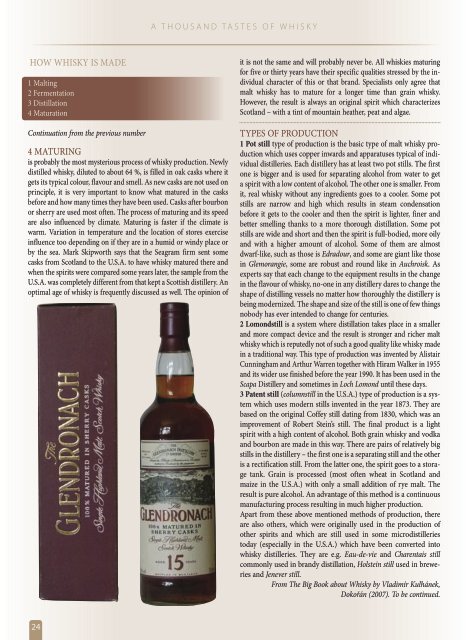3 I 2012 - Grandhotel Pupp
3 I 2012 - Grandhotel Pupp
3 I 2012 - Grandhotel Pupp
Create successful ePaper yourself
Turn your PDF publications into a flip-book with our unique Google optimized e-Paper software.
a thousand tastes of whisky<br />
How whisky is made<br />
1 Malting<br />
2 Fermentation<br />
3 Distillation<br />
4 Maturation<br />
Continuation from the previous number<br />
4 MATURING<br />
is probably the most mysterious process of whisky production. Newly<br />
distilled whisky, diluted to about 64 %, is filled in oak casks where it<br />
gets its typical colour, flavour and smell. As new casks are not used on<br />
principle, it is very important to know what matured in the casks<br />
before and how many times they have been used. Casks after bourbon<br />
or sherry are used most often. The process of maturing and its speed<br />
are also influenced by climate. Maturing is faster if the climate is<br />
warm. Variation in temperature and the location of stores exercise<br />
influence too depending on if they are in a humid or windy place or<br />
by the sea. Mark Skipworth says that the Seagram firm sent some<br />
casks from Scotland to the U.S.A. to have whisky matured there and<br />
when the spirits were compared some years later, the sample from the<br />
U.S.A. was completely different from that kept a Scottish distillery. An<br />
optimal age of whisky is frequently discussed as well. The opinion of<br />
it is not the same and will probably never be. All whiskies maturing<br />
for five or thirty years have their specific qualities stressed by the individual<br />
character of this or that brand. Specialists only agree that<br />
malt whisky has to mature for a longer time than grain whisky.<br />
However, the result is always an original spirit which characterizes<br />
Scotland – with a tint of mountain heather, peat and algae.<br />
TYPES OF PRODUCTION<br />
1 Pot still type of production is the basic type of malt whisky production<br />
which uses copper inwards and apparatuses typical of individual<br />
distilleries. Each distillery has at least two pot stills. The first<br />
one is bigger and is used for separating alcohol from water to get<br />
a spirit with a low content of alcohol. The other one is smaller. From<br />
it, real whisky without any ingredients goes to a cooler. Some pot<br />
stills are narrow and high which results in steam condensation<br />
before it gets to the cooler and then the spirit is lighter, finer and<br />
better smelling thanks to a more thorough distillation. Some pot<br />
stills are wide and short and then the spirit is full-bodied, more oily<br />
and with a higher amount of alcohol. Some of them are almost<br />
dwarf-like, such as those is Edradour, and some are giant like those<br />
in Glemorangie, some are robust and round like in Auchroisk. As<br />
experts say that each change to the equipment results in the change<br />
in the flavour of whisky, no-one in any distillery dares to change the<br />
shape of distilling vessels no matter how thoroughly the distillery is<br />
being modernized. The shape and size of the still is one of few things<br />
nobody has ever intended to change for centuries.<br />
2 Lomondstill is a system where distillation takes place in a smaller<br />
and more compact device and the result is stronger and richer malt<br />
whisky which is reputedly not of such a good quality like whisky made<br />
in a traditional way. This type of production was invented by Alistair<br />
Cunningham and Arthur Warren together with Hiram Walker in 1955<br />
and its wider use finished before the year 1990. It has been used in the<br />
Scapa Distillery and sometimes in Loch Lomond until these days.<br />
3 Patent still (columnstill in the U.S.A.) type of production is a system<br />
which uses modern stills invented in the year 1873. They are<br />
based on the original Coffey still dating from 1830, which was an<br />
improvement of Robert Stein’s still. The final product is a light<br />
spirit with a high content of alcohol. Both grain whisky and vodka<br />
and bourbon are made in this way. There are pairs of relatively big<br />
stills in the distillery – the first one is a separating still and the other<br />
is a rectification still. From the latter one, the spirit goes to a storage<br />
tank. Grain is processed (most often wheat in Scotland and<br />
maize in the U.S.A.) with only a small addition of rye malt. The<br />
result is pure alcohol. An advantage of this method is a continuous<br />
manufacturing process resulting in much higher production.<br />
Apart from these above mentioned methods of production, there<br />
are also others, which were originally used in the production of<br />
other spirits and which are still used in some microdistilleries<br />
today (especially in the U.S.A.) which have been converted into<br />
whisky distilleries. They are e.g. Eau-de-vie and Charentais still<br />
commonly used in brandy distillation, Holstein still used in breweries<br />
and Jenever still.<br />
From The Big Book about Whisky by Vladimír Kulhánek,<br />
Dokořán (2007). To be continued.<br />
24
















